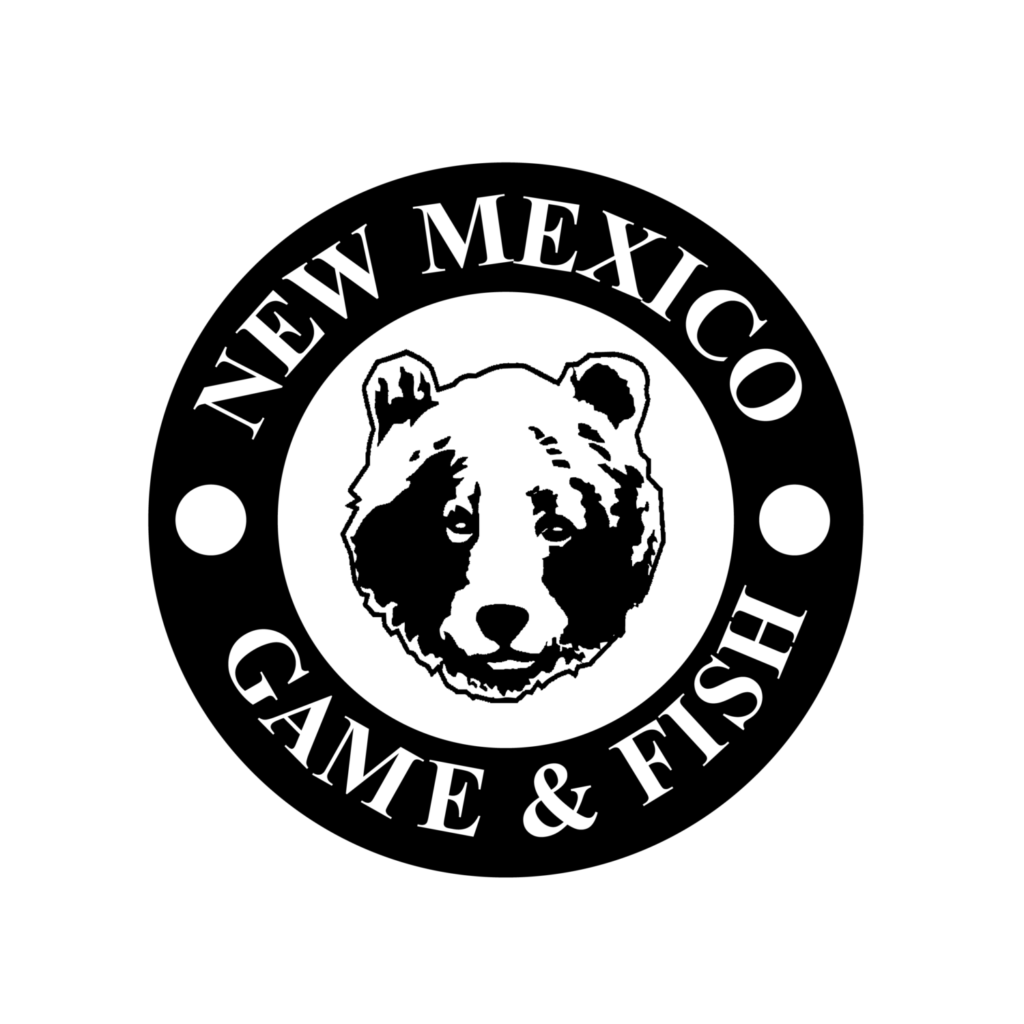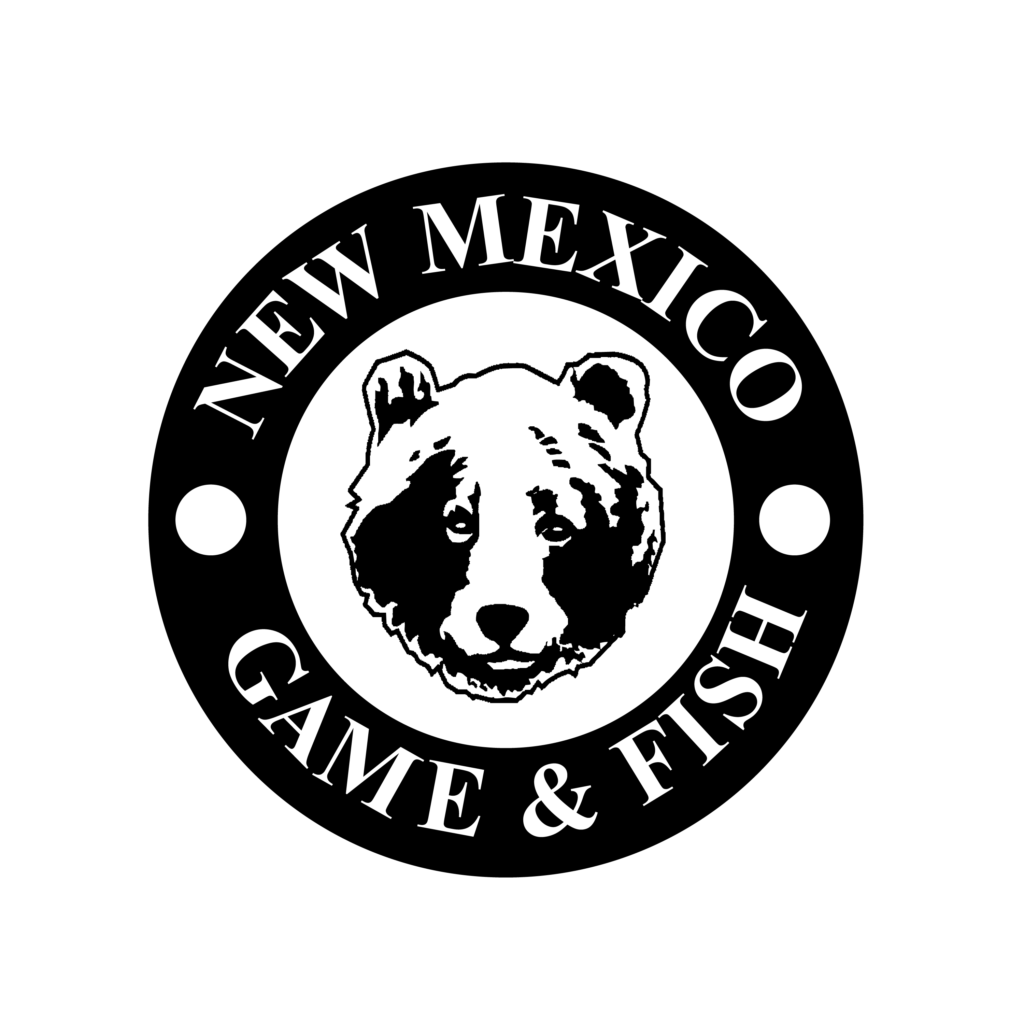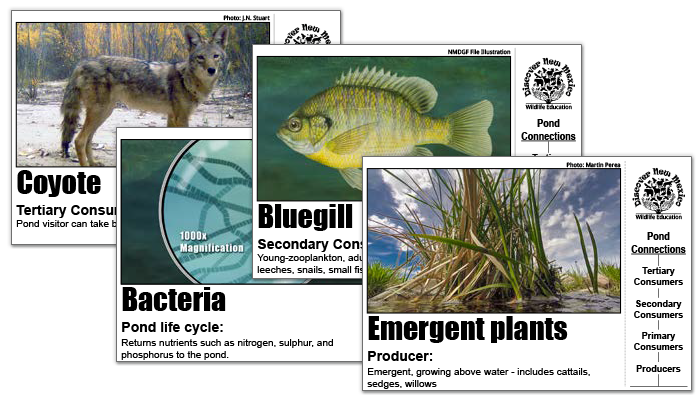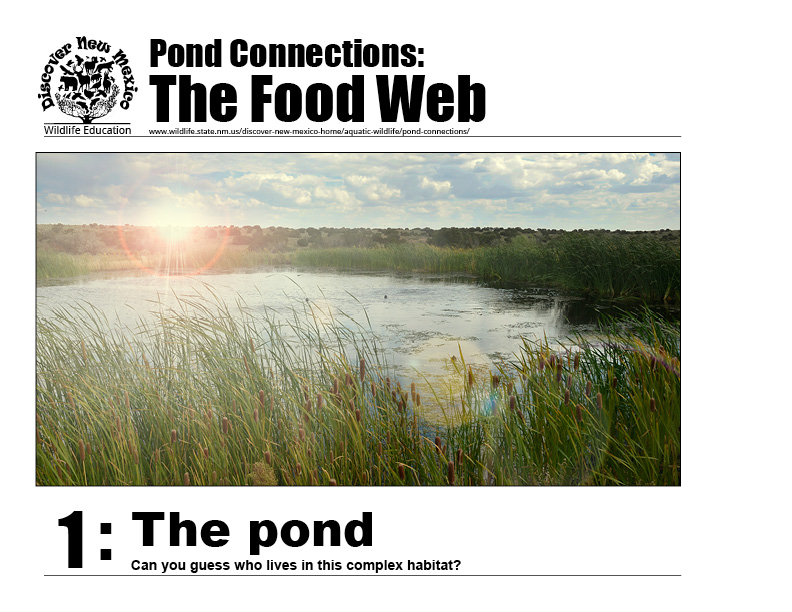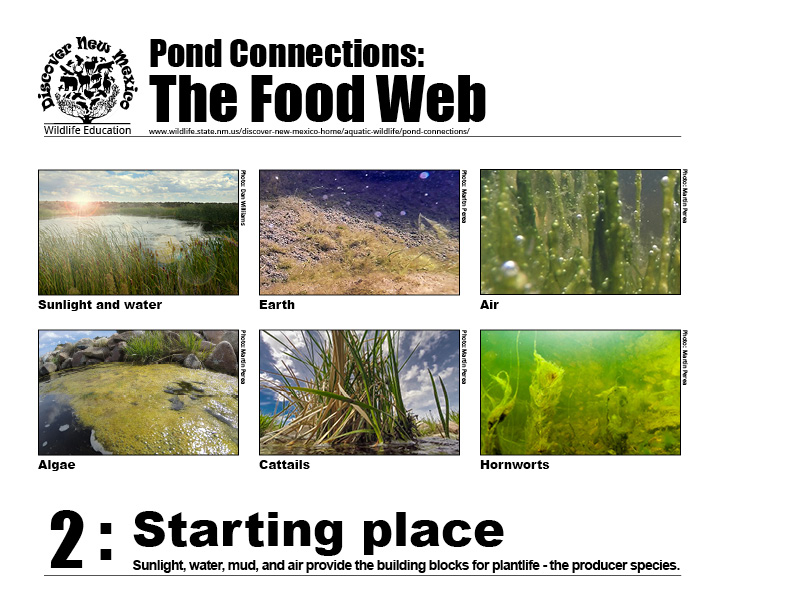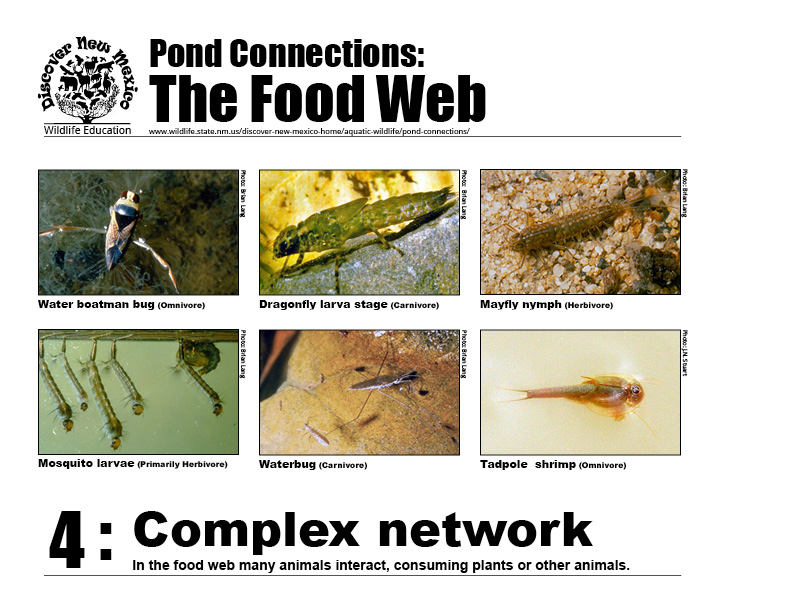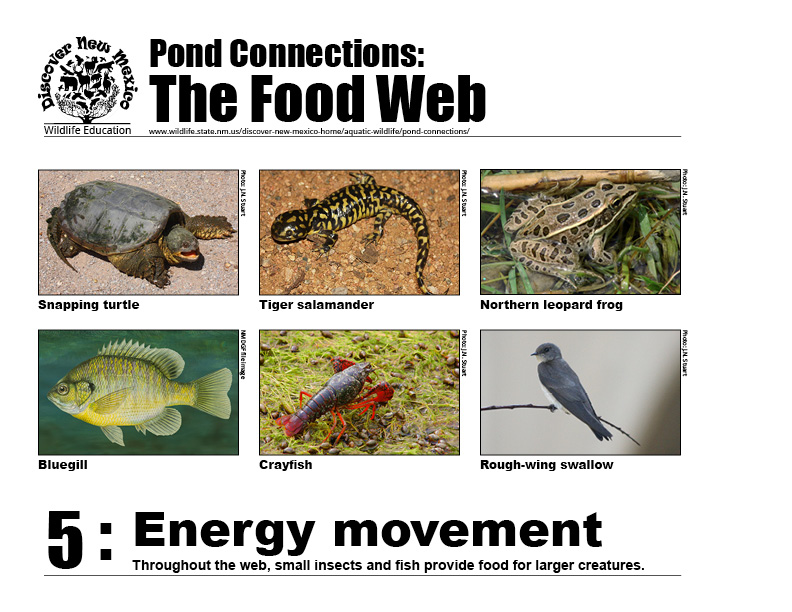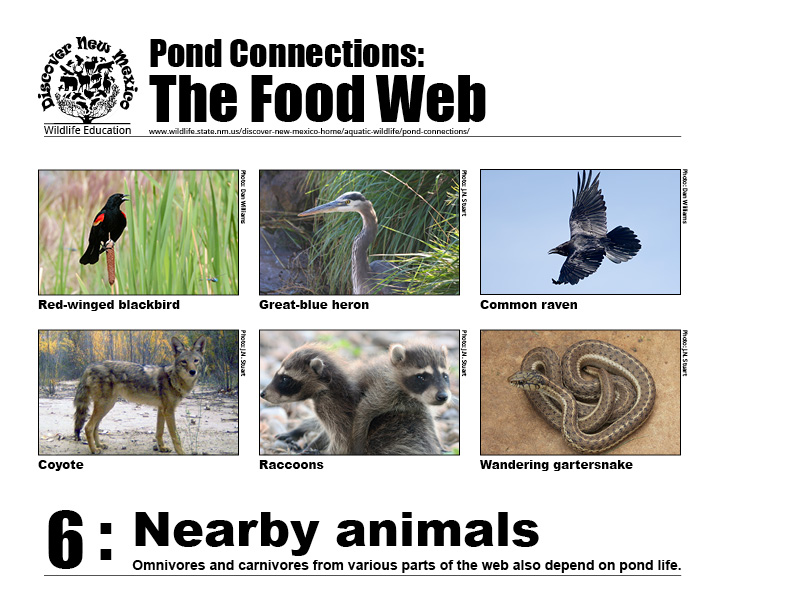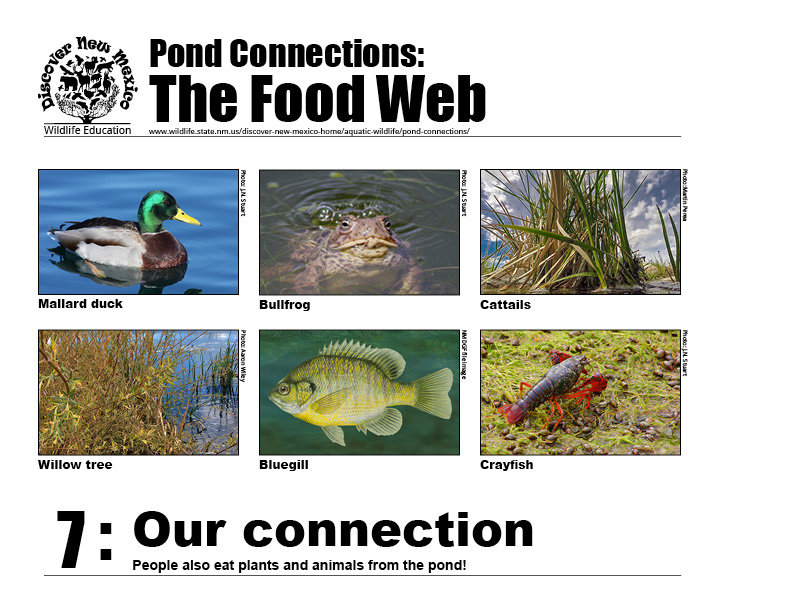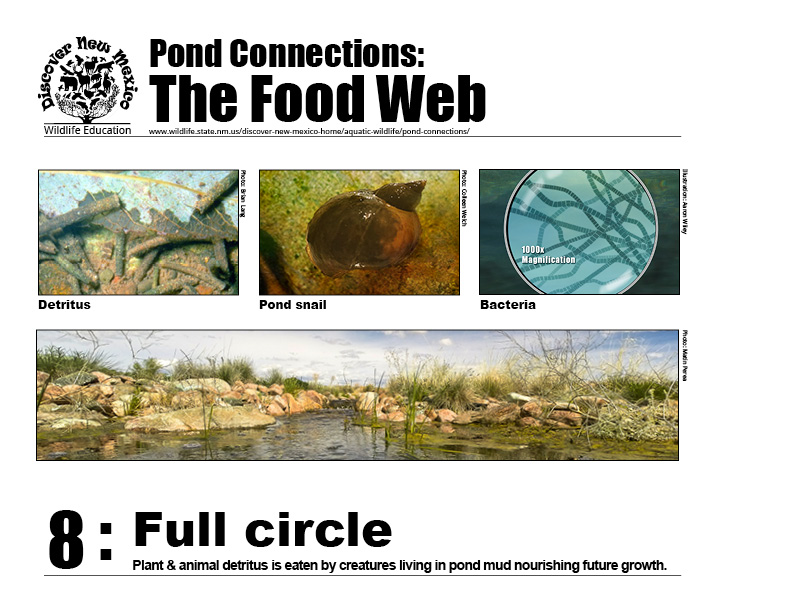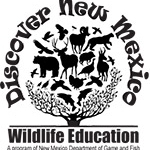
Pond Connections
Ecosystems differ depending on the living and non-living things within them and how those things interact with each other. Ecosystems supply organisms with the specific food, water, shelter, air and space they need to survive. This lesson guides students to discover the different plants, animals and non-living things in ponds.
Overview
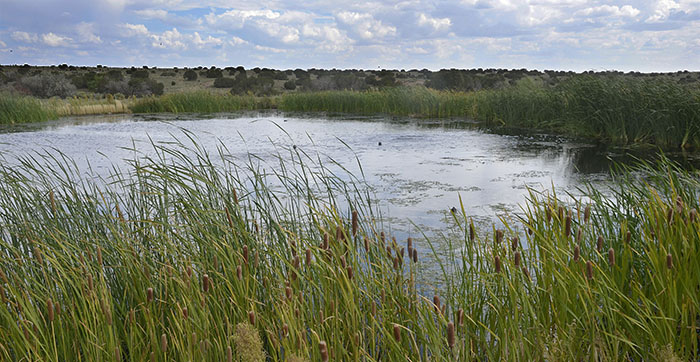
Cattails border the water’s edge of high desert pond near Santa Fe. Photo by Dan Williams.
Grade level: Primarily 4th, 5th, middle school. (A few High School extensions are included but not expanded.)
Content Areas: Science, English/Language Arts, Fine Art, Technology
Objectives: Special Note to educators that this lesson can be quite inclusive, and broadly meet NM Science Standards at multiple grade levels. Our intent is to focus on upper elementary and middle school. Lesson addresses these lower grade levels. High School teachers may use and adapt this lesson as needed.
Students will be able to:
1. Identify common plants and animals living in an aquatic pond.Students in higher grades identify microscopic protists such as brown algae and Paramecia.
2. Create food chains and a food web for a pond ecosystem, showing relationships at various levels from producers who get energy from the sun to primary consumers, secondary consumers, and tertiary consumers. Students in higher grades include more such as symbiosis, mutualism, flow of energy through pond system and biodiversity.
3. Students understand that a pond ecosystem is made up of the non-living or abiotic parts and the living or biotic organisms that make up the whole pond community.
Method: Students become familiar with common organisms found in a freshwater pond by viewing a slide show, doing research using books and the internet. Field investigations at an actual pond is highly encouraged. Two pond life card lists are provided on Procedure page.
1. A picture card set for elementary and middle school teachers to use.
2. High school teachers may want to use set where students create images and do research. Students sketch or find a picture from other sources of their selected organism. If selection is an animal, the completed card will include what that animal eats. If selection is a plant, students can sketch, find illustrations or photograph actual plant at a nearby pond.
Pond life cards include names of plants, animals and other organisms typical of a freshwater pond. Using their cards, students create food chains and food web by showing connections between organisms. Students use their science notebooks to answer questions throughout lesson and activities.
Materials:
[wpfilebase tag=file id=1480 tpl=filebrowser /] [wpfilebase tag=file id=2136 tpl=filebrowser /] [wpfilebase tag=file id=1482 tpl=filebrowser /]• Student page
• Science notebooks
• PowerPoint slide show on pond food web (found under Procedure tab)
• Art supplies such as colored pencils and colored markers
• Cameras are optional depending on actual visit to a pond where photographs can be taken. Many cell phones now have good cameras and most students have Smart Phones with cameras.
• Wildlife magazines that can be cut up for images are also an option
• Materials for pond discoveries in the field include: nets, containers, forceps, plastic spoons, ID charts, microscopes and hand lenses.
• See Special Resources listed at end of lesson.
Lesson and Activity Time: 3 to 4 class sessions with optional field trip time
Location: Indoors with optional field trip to a pond
Academic Standards: [wpfilebase tag=file id=2062 tpl=filebrowser /]
Vocabulary
Trophic levels, biotic, abiotic, organism, hydrophytes, nymph stage, food chain, food web, producer, primary consumer, secondary consumer, tertiary consumer, detritus, protists
Background
Ecosystems differ depending on the biotic–living and abiotic–non-living things within them and how those components interact with each other. Ecosystems supply organisms with the specific food, water, shelter, air and space they need to survive. This lesson guides students to discover the life in pond communities.
A pond is an enclosed body of fresh water and most ponds are very busy places. On hot summer afternoons, they may appear to be sleepy, but by listening and watching closely one can discover that ponds are actually a-buzz with life. A large bird may be seen standing in the water without moving a muscle, watching for prey. A turtle may be seen basking on a log in the sun. Dragonflies and damselflies abound with busy flight, perching here and there on tassel-topped reeds or duckweed floating in the water with spikes above the surface, just right for a quick stop. Baby birds can be heard peeping from their nests hidden deep in the cattails. An adult mallard duck pair might be seen with chicks in tow. American coots, duck-like birds, may be swimming about diving for duckweed and other good aquatic plants to eat. Numerous red wing black birds will most likely greet anyone coming to a pond with their raucous calls. Small fish can be seen swimming among the various submerged pond weeds.
Pond ecosystems are home to many organisms that live in or near the water. Pond communities of plant and animal populations have exactly what they need to survive and intricate food webs exist between all of the organisms. Some pond organisms live in the water for all or part of their life. Some, like dragonflies and damselflies, start their lives in the water, but after developing in a nymph stage, they emerge as flying adults. Some animals live near the water and depend on pond plants and animals. For example, red wing black birds have nesting sites within cattails and other pond plants. Swallows flit above pond water eating recently emerged mayflies that have left the pond where their lives started. Coyotes, skunks and raccoons visit ponds for drinking water and to find their dinner. These land-based mammals can eat aquatic waterfowl or their eggs.
At every layer of the pond, organisms depend on the interaction between water, soil, sunlight, and air. The mud at the bottom of the pond is full of nutrients for organisms. The mud provides places for the seeds of water plants to sprout and grow. Water-loving plants, called hydrophytes, provide shelter and cover for organisms. Examples include cattails, sedges and rushes.
Most ponds are shallow enough for sunshine to reach the bottom. The sunlight warms the water and creates different layers of light. Organisms can use these layers in different ways to find the food and cover they need to survive.
Aquatic ecosystems such as ponds have intricate food webs consisting of many interconnected food chains. Basic food pyramids demonstrate plants at the base as the producers. The next trophic level up consists of the primary consumer. Above this level are the secondary consumers and on up to the tertiary consumers. Trophic levels consist of groups of organisms that share the same level in the food chain. The various consumers may be herbivores-plant feeders, omnivores-feeding on plants and animals, as well as carnivores-meat eating organisms.
[wpfilebase tag=file id=1482 tpl=simple /]Procedure
Lesson:
1. The best way to introduce this activity is to actually go to a pond site. Preparation includes downloading the Pond Life Card Set (below) that you want to use. You may want to prepare a model paper pond. If you have access to large sheets of colored paper, cut out a large blue oval and border it with a larger green ring of paper. Prepare a smaller dark brown oval to represent the mud bottom of the pond. Fabric may also be used. Place this model in an open area on a large table or on the floor.
2. Ask students if they have visited a pond. Books and the internet can also provide pictures and information on ponds and pond life. See the resource list at the end of this lesson for web links and information on bus funding.
3. Brainstorm what students already know about pond life and begin a KWL list—(What we know; what we want to know; what we learned.)
4. Show slide show (below) on Pond Life Food Web, included with lesson. Discuss where students think the animals pictured in the slides live. For example, the insect nymphs live in the water near the surface and are swimming near the pond plants that they can hold on to. The American coot is swimming throughout the pond while the red-winged blackbird flits about the tall cattails and willows. They will nest within these plants.
5. Using the [wpfilebase tag=file id=1480 tpl=filebrowser /]:
a. Divide students into 4 or 5 groups:
1. Organisms that live near the bottom (catfish).
2. Organisms that primarily live below the surface of the water (insect nymphs, some pond weeds).
3. Organisms that live above the surface (ducks, cattails).
4. Organisms that fly above the pond (adult dragonflies, birds).
5. Organisms that visit the pond for water or to hunt for prey (coyote).b. Suggested informational books to read are listed on Special Resource page.
c. Allow time for groups to discuss their cards and where they will place them on the mock pond ecosystem that has been set up using paper or other material.
d. Each group places their cards in the model ecosystem. Teacher leads whole class discussion. Does everyone agree with plant and animal card placement? Should certain cards be in another level of the food web? How do you know? (Refer back to the PP slide show, books read, prior knowledge
e. Students create food web using cards. Start with simple food chains and progress. See lesson called Tugging on a Habitat for more ideas on creating a food web.
f. Students may change their card’s position after learning more.
6. Whole group discussions on biotic and abiotic organisms (air, sun, living organisms).
7. Discussion on vocabulary relative to creating web for pond ecosystem. Teacher helps to reinforce understanding and correct misconceptions.
8. Allow students to move cards to placement on mock pond model, based on discussion.
9. Students use science journals/notebooks throughout this lesson to record notes of observations while visiting a pond, information about food chain and webs as related to pond organisms, vocabulary words defined as related to activity, questions they still have, and/or reflections on pond life. Students record information they have found from research on pond life, providing sources of information.
Student Page
Questions for each student to answer in science notebooks. Teachers may change or add additional questions:
- Which pond organisms are producers?
- List primary consumers, secondary consumers and tertiary consumers in a pond ecosystem and list prey for each level.
- What would happen to the food web if the aquatic plants died out because of pollution?
- What would happen to the food web if the population of great blue heron was to double?
- New Mexico has both natural and constructed ponds. Consider the aridity of the region and the length of droughts. Discuss why conserving ponds is important to both people and to wildlife.
http://droughtmonitor.unl.edu/Home/StateDroughtMonitor.aspx?NM - How would the introduction of the common carp (also known as Asian carp) affect the food web? (Carp consume zooplankton, which many fishes typically feed on in their juvenile stages. Carp have no known predators. See lesson called Aquatic Aliens-Too Close for Comfort.)
Resources
Lesson PDFs:
- [wpfilebase tag=file id=1480 tpl=simple /]
- [wpfilebase tag=file id=2136 tpl=simple /]
- [wpfilebase tag=file id=1482 tpl=simple /]
Books:
- Reid, George K. Pond Life-A Golden Guide. New York: Golden Books Publishing Company, Inc. 1995.
- Silver, Donald M. One Small Square Pond. New York: Learning Triangle Press, 1994.
- Slattery, Echkardt, Britt. WOW! The Wonders of Wetlands, MD and MT: Environmental Concern Inc. and The Watercourse, 2003.
- Barrett-George, Lindsay Around the Pond: Who’s Been Here? New York: Greenwillow Books. 1996.
- Clegg, John The Observer’s Book of Pond Life. London, UK: Godfrey Cave Associates Ltd. 1992.
- Parker, Steve Eyewitness Pond and River. New York: DK Publishing, Penguin, 2011,
Links:
Selected New Mexico ponds:
- NM Department of Game and Fish main office in Santa Fe has a constructed and well-established pond. Call to make reservation at 505-476-8119 or 476-8095.
- Rio Grande Nature Center, Albuquerque, Discovery Pond on site. Contact 505-344-7240.
- Cowles Ponds, Pecos Wilderness, Santa Fe National Forest, State Hwy 63 north from Pecos, NM. Ponds are open to the public for fishing, including a kids’-only fishing pond.
Field Investigations at a pond:
• NM Department of Game and Fish, Aquatic Education program, has an aquatic field trunk that can be checked out from the Santa Fe office. Trunk includes Brock Macroscopes, ID charts, trays, small nets and more.
• State Parks may have bus funding grants to one of their parks. Rio Grande Nature Center State Park in Albuquerque has a discovery pond. www.emnrd.state.nm.us/SPD/Outdoor%20Education/OutdoorEducation.html
